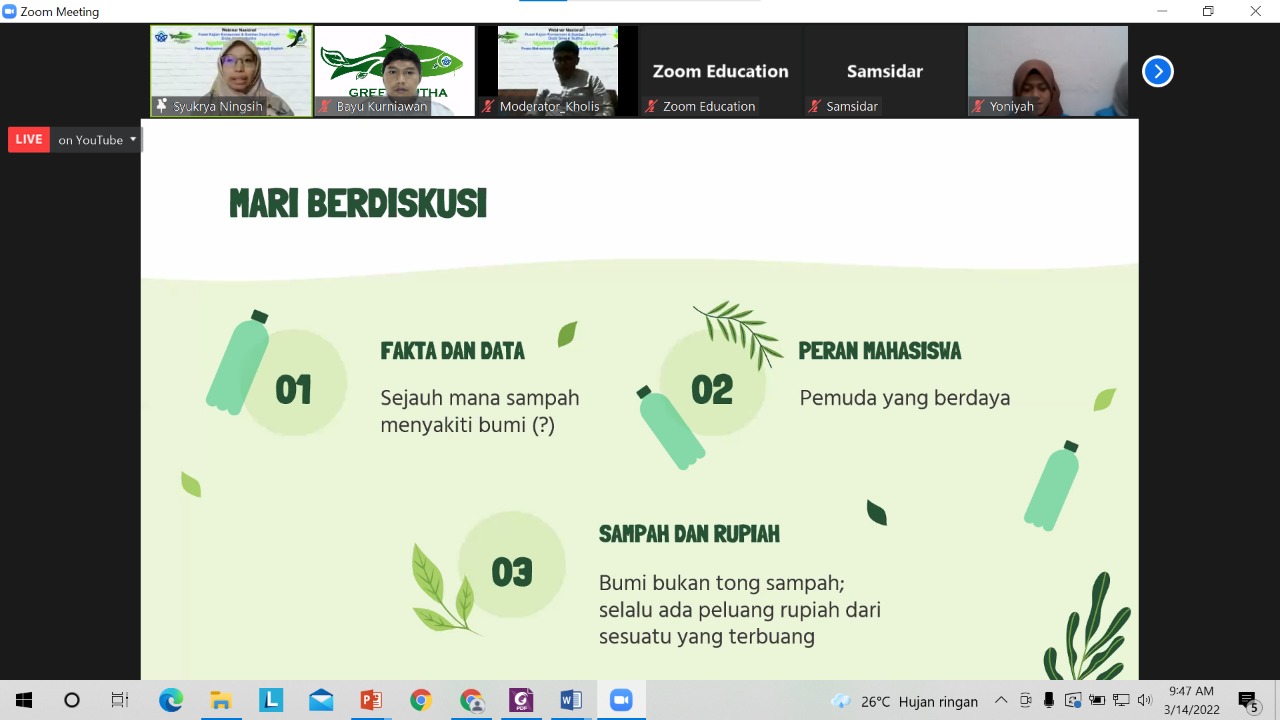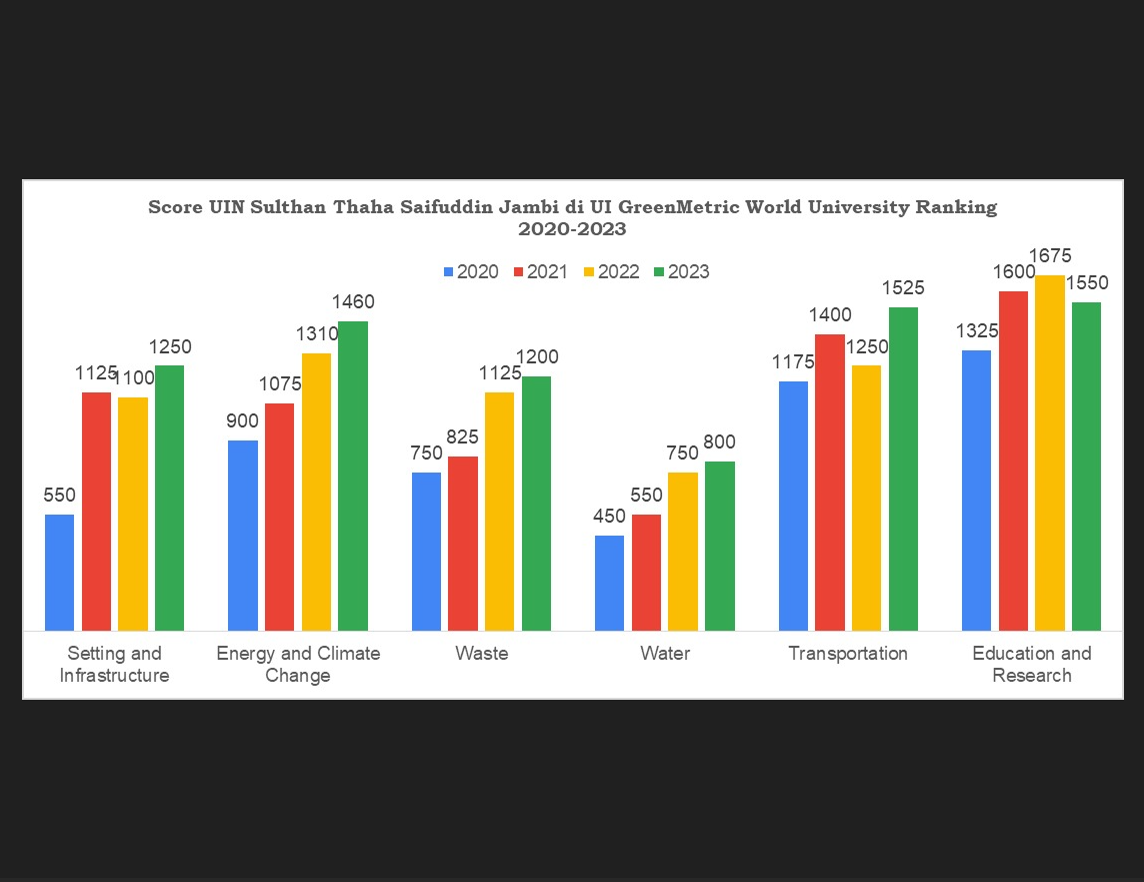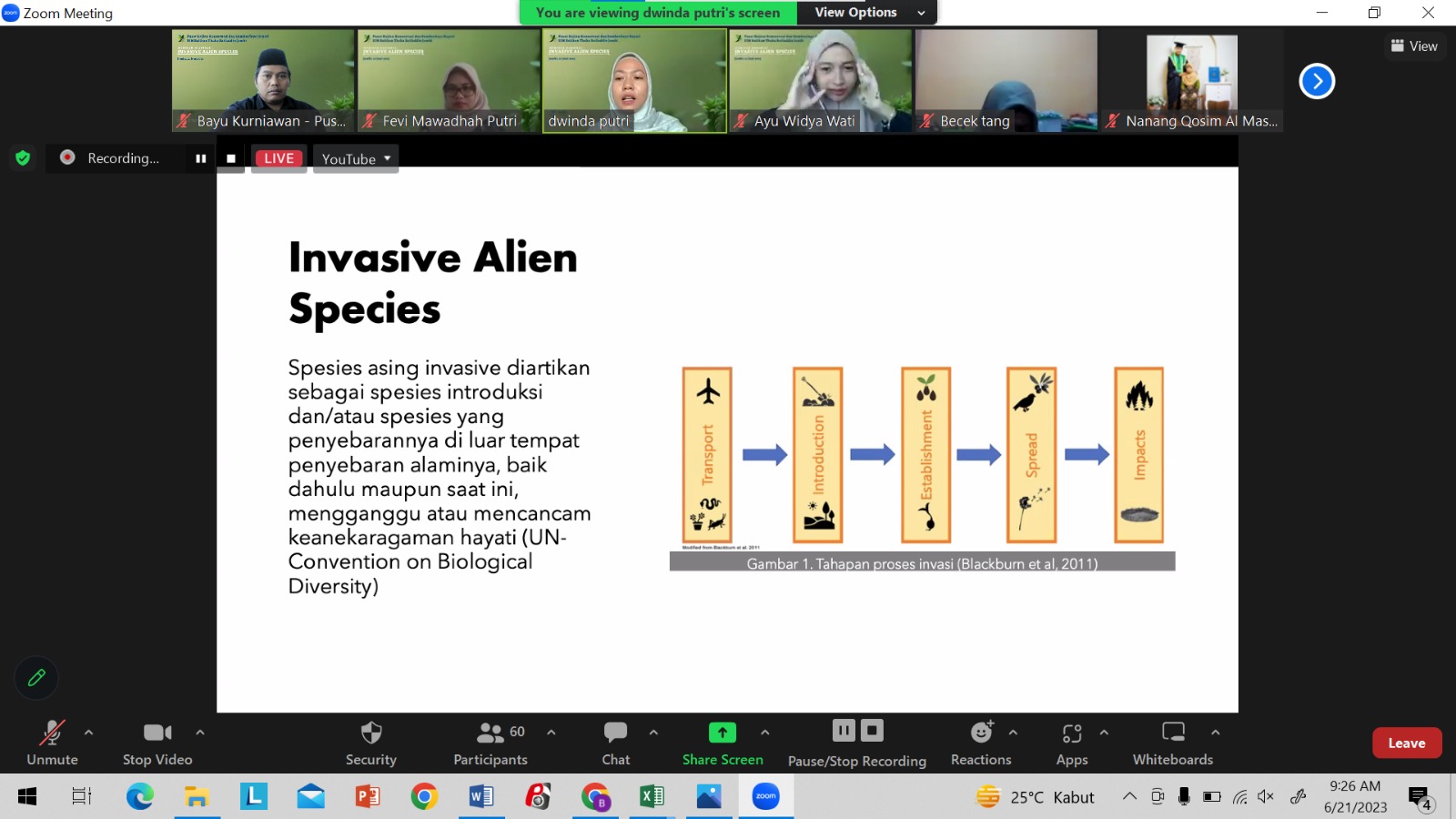Transforming Trash into Cash: The National Webinar by The Conservation and Biological Resources Study Center and The Green Sutha Ambassador

The National Webinar – the Green Sutha ambassador in collaboration with Center of the Study for Conservation and Biological Resources has succeeded in organizing a National Webinar that has been held on Monday, March 14th, 2022. This event brought up the theme "The Roles of College Student Transforming Trash into Cash” with a welcome speech from the Head of Center of the Study for Conservation and Biological Resources, Bayu Kurniawan, S.Si., M.Sc. The main Presenter on this National Webinar was the Head of the Center for Environmental Studies of UIN STS Jambi and the National Eco-Enzyme Team under the UI GreenMetric World University Rankings, Syukrya Ningsih, S.Si., M.Si. This event was also supported by many supporting presenters such as the 2021 Green Sutha ambassador, Yoniah, the student of Biology Education Program; the 2022 Green Sutha ambassador, Ririn Princess Rahayu, the student of Madrasah Ibtidaiyah Teacher Education, and alumni of National Students of Leaders on Sustainability Meeting, Achmad A and Azzuri.
This event was attended by 170 college students from various universities in Indonesia, namely:
- UIN Sulthan Thaha Saifuddin Jambi,
- Universitas Batanghari
- IAIN Kerinci
- Universitas Muhamadiyah Hamka (Uhamka)
- Universitas Halu-Uleo
- STKIP-YPM
- Telkom University
- UIN Raden Fatah Palembang
- STIE Panca Bhakti Palu
- Institut Teknologi Sumatera (ITERA)
- Universitas Jambi
- UIN Imam Bonjol Padang
- UIN Surabaya
- Universitas Kristen Duta Wacana
- Universitas Nahdlatul Ulama Kalimantan Barat
- Universitas Al-Agifari Bandung
- Universitas Negeri Riau
- IAIN Cirebon
- SMA Kota Jambi
- Universitas Negeri Yogyakarta
Bayu Kurniawan, S.Si., M.Sc. as the Head of Center of Study for Conservation and Biological Resources conveyed the importance collaboration among college student and lecturer in handling trash and waste around us. Higher Education have important roles in mitigation of climate change and environment pollution as the consequence of irresponsible human acts. Through the Green Sutha ambassador, we hope that this Green Campus program can be achieved optimally in handling environmental problems. The Green Sutha ambassador was formed in 2021 as a student organization activity to support the world ranking program through the UI GreenMetric World University Rankings. Students as future leaders must be able to make innovations that can change the world view. One of the programs that can be implemented is converting trash into cash. Trash or garbage is an item that does not have a high selling value, but with students’ creativities, waste that was originally not valuable has become a luxury item with high value and has many benefits. Along with his closing speech, the National Webinar with the theme of “The Role of Students Turning Trash into Cash” was officially opened.
This webinar is one of the Green Campus programs initiated by the Green Sutha ambassador as support for world rankings through the UI GreenMetric World University Rankings on the Waste indicator. Waste is a serious problem for the environment. Based on the Science Direct Journal, the results of research conducted by Sudibyo et al. (2017), in one of the largest provinces in Indonesia produced 470 tons/day consisting of 77% organic waste and 33% inorganic waste. The high accumulation of waste can of course lead to serious environmental problems if not managed properly. This waste management can be started by sorting the waste in the household before entering the final disposal site (TPA).
The Green Sutha ambassador of UIN Sulthan Thaha Saifuddin Jambi which was fostered by the Center of Study for Conservation and Biological Resources and the Center for Environmental Studies took initiatives in handling waste by conducting socialization through webinars on the use of trash into cash. All waste, of course, still has a use value if it can be managed properly.
In this webinar about waste solutions, the Head of Center for Environmental Studies, Syukrya Ningsih, S.Si., M.Si, as the main speaker conveyed student tips in building ideas in environmental solutions. Creativity is an inseparable part of the thinking of the campus academic community, especially students, where creativity is the ability to produce new things that have never existed before. The process to produce new things can come from the imaginative process of the creator himself, can also come from previous information and experience regarding the thing to be created, then the creator combines and renews existing works or ideas to produce new works or ideas, and different from the previous works. Creativity is a process or ability that reflects fluency, flexibility and originality in thinking, as well as the ability to elaborate (develop, enrich, detail) an idea. This understanding emphasizes the aspects of the change process (innovation and variation). Finding ways outside the ordinary or out of the box thinking, is highly demanded by all parties, so the term "anti-mainstream" thinking appears. As students we are required to be more creative and innovative. Creative in finding new ideas and innovative in finding new ways to deal with existing problems.
The second presenter, student from Tadris Biology, Yoniah, shared about the management of rubbish paper into rupiah. The results of sorting paper waste in the household and campus environment can be converted into various valuable items including flower vases, tissue holders, mineral water containers, pen holders, etc. The method used is quite simple in this paper waste management. First, waste paper that is not useful is collected and then sorted by its size and type. Second, after sorting the paper, it is twisted to resemble small wood. Third, the results of the twisted paper are then assembled, then mixed with paper glue or other glue so that the twisted paper is easily shaped according to the desired design. Fourth, after it is formed according to the desired design, the next stage is coloring it with paint or varnish to add aesthetic value and selling value. The last stage is to do promotions either through the Green Sutha website or our Instagram as well as through other social media. The prices offered are very competitive, and of course with the best quality.
The third speaker is PGMI student, Ririn Princess Rahayu, has shared about the process of making the eco-enzymes. Eco-enzyme is a product of fermented organic materials such as fruits and vegetables without any previous cooking process. The process of making this eco-enzyme is quite easy, by using the main ingredients, namely water, molasses/brown sugar, fruit/vegetable skins in a ratio of 10: 1: 3 in a row. These materials are obtained in various ways. More precisely, by prioritizing the green campus program, namely:
- The water used is obtained by collecting AC water that is wasted in vain. Through the activities of the Green Sutha ambassador, AC water is collected using jerry cans on a regular basis, monitored, and taken to be accommodated in a larger container.
- The fruit skin used is obtained by taking peeled fruit from the campus canteen that sells juice, or leftover vegetables that are not cooked by the canteen.
- Molasses can be purchased from a store or either by buying it online.
The fermentation process in this eco-enzyme making takes a relatively long time, ranging from 90-100 days. This eco-enzyme harvesting process can be carried out after entering the 100th day to get good fermentation results. When harvesting eco-enzymes, there are derivative products that can be produced, namely fermented fruit skin which can be used as compost. The harvested eco-enzyme is then filtered to get a “magic liquid” which has many benefits, such as detergent, floor disinfectant, substitute for floor/glass cleaning fluid, water purifier (purification), air purifier, hand sanitizer, etc.



.jpeg)
